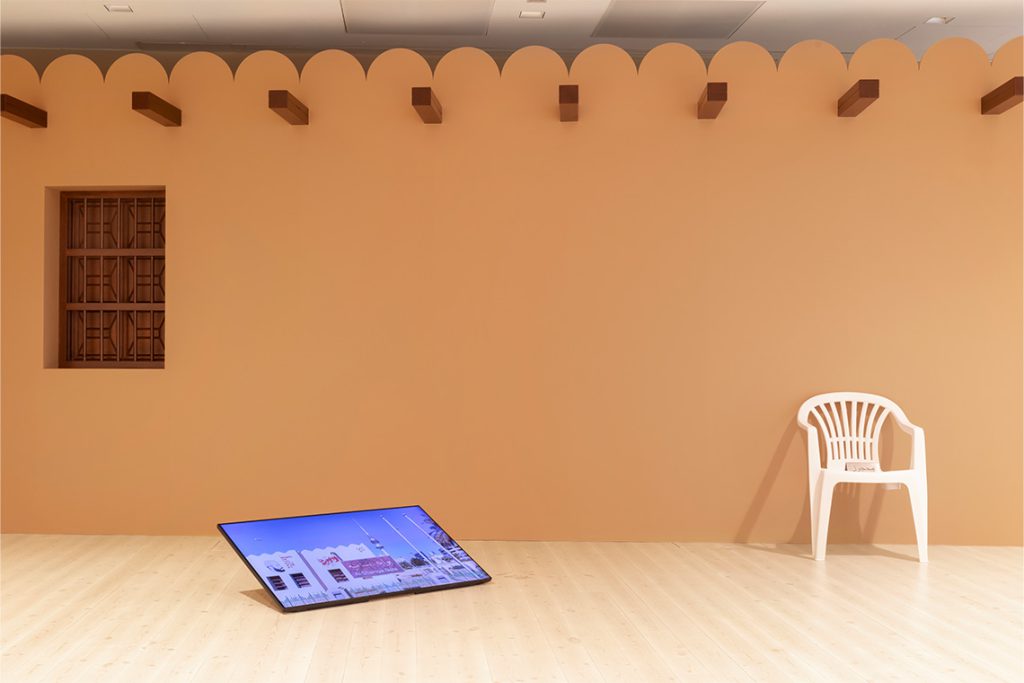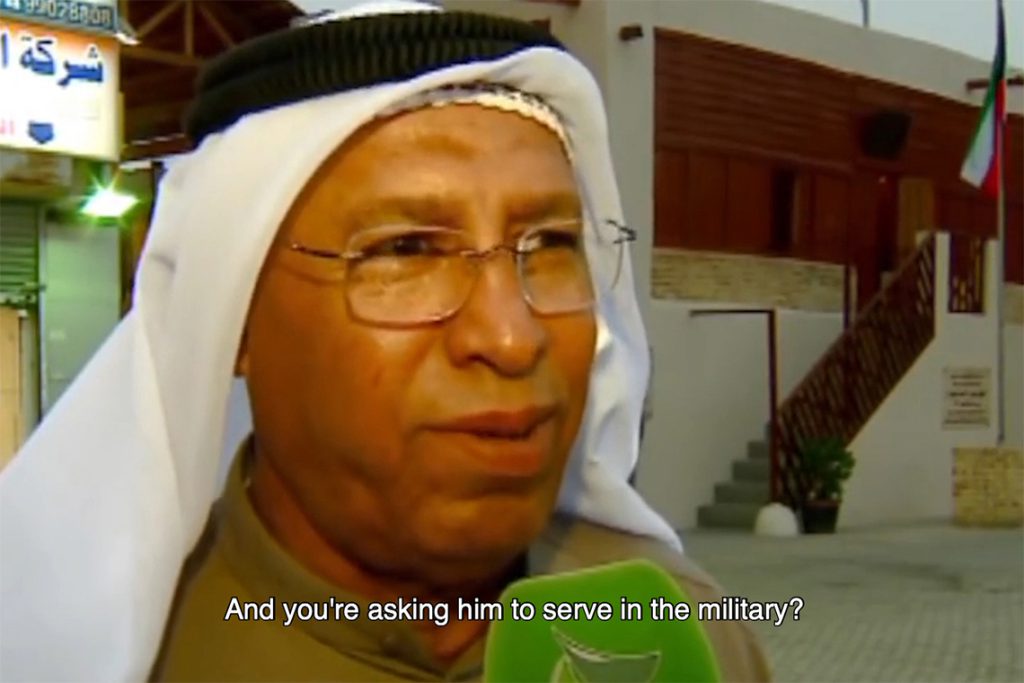The Kuwaiti artist speaks about the power of image-making and reclaiming colonial historical narratives through research, as well as the potential for art to rewrite the past.
Canvas: Let’s start with your current solo exhibition at Bildmuseet, The View from Above. What does the title signify and how does it illustrate the methodology in your practice?
Aseel AlYaqoub: Anca Rujoiu, the curator, suggested the title. My practice often reappropriates the colonial lens, whether through cartography, urban planning or as a tool to analyse nation-building. Historically, we were mapped from above. The first Kuwait Master Plan was designed from an aeroplane by the British, which translated into bureaucratic and institutional developments in Kuwait. The methodology became a tool for me to re-analyse Kuwait’s colonial history and its impact on institutions.
Your work is looking at Kuwait from the early post-colonial era to the present day. Why this time period in particular? Your video installation, 100 Soldiers Somersaulting (2020), seems especially relevant in this respect.
100 Soldiers Somersaulting is 45 years of Kuwait’s history condensed into 45 minutes. I use a lot of parody and archival footage. I was fixated on military parades and fascinated by the idea of nation-building as theatre-making, specifically with Kuwait being the only GCC country that has experienced an invasion in modern times. Despite Kuwait’s independence in 1961, the British protectorate did not really end until the Gulf War, when the Americans replaced the British, but in a different way. The video’s title is about this act of repeating, and of history recurring over and over again. The idea of omitting the past in Kuwait also drove me. Younger generations of Kuwaitis have no idea we were even colonised.
How do you navigate complex subjects such as nationhood and Arab identity?
Instead of saying what ‘Arab’ means, I try to show what it doesn’t mean. For example, one of my projects is about the shemagh, which I found out was designed by the British Lieutenant-General John Bagot Glubb to differentiate from the keffiyeh and integrate the Bedouin community into the nation. The shemagh became an Arab national symbol with the advent of Pan-Arabism. But it’s not our tradition, it never belonged to us. I don’t think we need to abandon it, just to be aware of its history. This is what I call colonial mimicry, an unconscious act of looking at the coloniser as something superior and mimicking them.

Thinking back to your earlier work Culture Fair (2018), how did you play with the tension between imagined and documented histories in your work?
I was looking at postage stamps from the golden era in Kuwait, from 1940 to 1980, a form of utopic vision that made me feel nostalgic for a time that I didn’t even belong to. Then I started to be more critical, to question who this fantasy notion served – maybe an elite minority? I began dissecting these rare stamps with a magnifying dome and a medical scalpel, in order to reassemble them into vignettes of historical moments and reflect on what is currently happening. If ‘they’ can omit history, I can reinvent it.
Can you elaborate on the importance of symbols and narratives in your quest to engage with Kuwaiti nationhood?
We have the omitted history of heritage here, as with the concentric walls that once surrounded Kuwait City and which I represent in Heritage Wall no. 6 (2015). It’s a gypsum wall that is simulating something, but it has studs behind it, like a theatrical set meant to represent heritage. The British saw the desert as an empty wasteland, so we demolished this wall that protected us for centuries because it didn’t fit into the new national narrative. There was nothing left from the past other than a few minor artefacts here and there. If there’s no history, then what is history?
What are your thoughts on the power of the image, particularly when it comes to mass media and artificiality, such as in your installation with Alia Farid, Contrary Life: A Botanical Light Garden Devoted to Trees, at Jameel Arts Centre in 2018. Is this theme still present in your practice?
Yes, it continues in this idea of reclaiming nature as part of our identity, and questioning why this aspect of history is omitted. Nation-building is imposed on a natural landscape, in the countries that cannot afford to irrigate replace the natural with the artificial. It’s a metaphor for other things, such as replacing the indigenous with the non-indigenous. Art Jameel was a response to this dimension and to the light culture there. Even in Kuwait we coat our landmarks in strings of light, this idea of “Yes, we do replace the natural with the artificial, but it’s so pretty”. It’s the seductive power of this type of media and the introduction of the ‘other’ into our lives that together perpetuate the form of mimicry that we still follow.

Image courtesy of the artist
How does re-exploring and reshaping the nation through archives allow you to reclaim a sense of ownership over Kuwait’s history and challenge existing narratives?
I love YouTube, and from there I find books to read. British archives are one of my go-to’s. Knowing what they’re saying is important in terms of finding the counter-narrative to it, either through Arabic or local historians or talking to the elderly here. I’m on a journey to understand my positioning within that history. While I was doing my research, I found out that my great-great grandfather was an anti-imperialist who fought against the British in Basra, Iraq. This is another instance of different versions of history existing side by side. The British accounts call him a brute, a thief, because he fought against them and was eventually exiled to Ceylon, now Sri Lanka. But Iraqi accounts call him the Lionheart, or Robin Hood, because of his bravery. It’s insane how these accounts are so different based on which point of view you take on.
Can you say something about the role that imagination plays in your reconstruction of memories? Your series of graphite drawings, Imagining the Imagined in the Imaginary (2021), seems to touch on this area.
The original National Museum of Kuwait, before it was destroyed during the Gulf War, was the Sheikh Khazal Palace. It was converted into the National Museum in the 1940s, but there’s barely any documentation on it, so I began collecting anything I could. It was more of a time capsule than a museum, trying to preserve the present for the future. The building itself has not been reconstructed. I wanted to pretend that I had been there by making museum drawings that reinterpreted and documented it. I enlarged these tiny images into spatial aspects, in a ghostly way, while the pencil I was using took on an ephemeral quality as well.
How does challenging historical narratives and archives impact future generations?
I’ve hoarded so many things over the past 10 years. I think of artists as archivists and collectors. My studio is almost a mini-museum. I run these studio spaces for artists in Kuwait, all younger than me. We share our resources, and the documentation and questions become a driving force for them. The collection then becomes the museum. History isn’t fixed. I always say to any aspiring young artist in Kuwait that linear history is a Western construct. We’re allowed to circle back, go on a tangent and even rewrite the past.
This interview first appeared in Canvas 116: Time After Time



